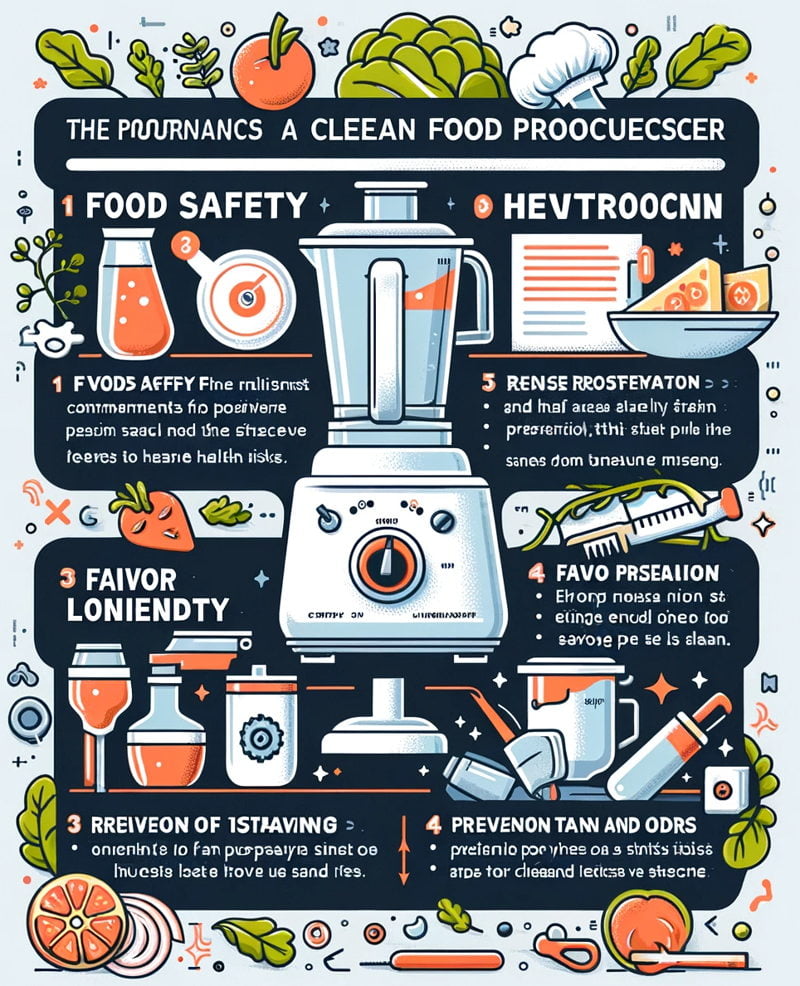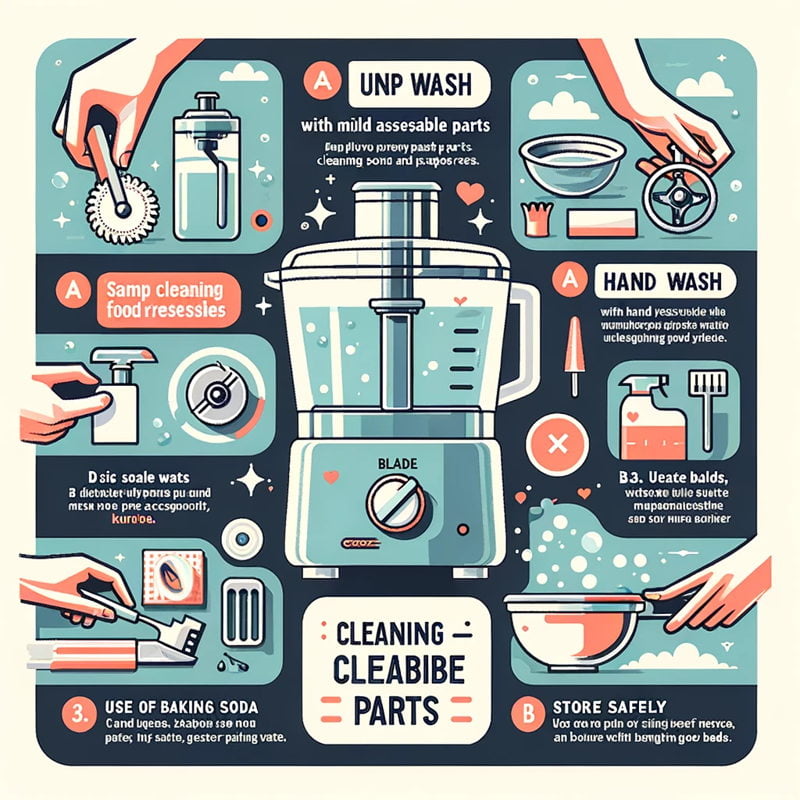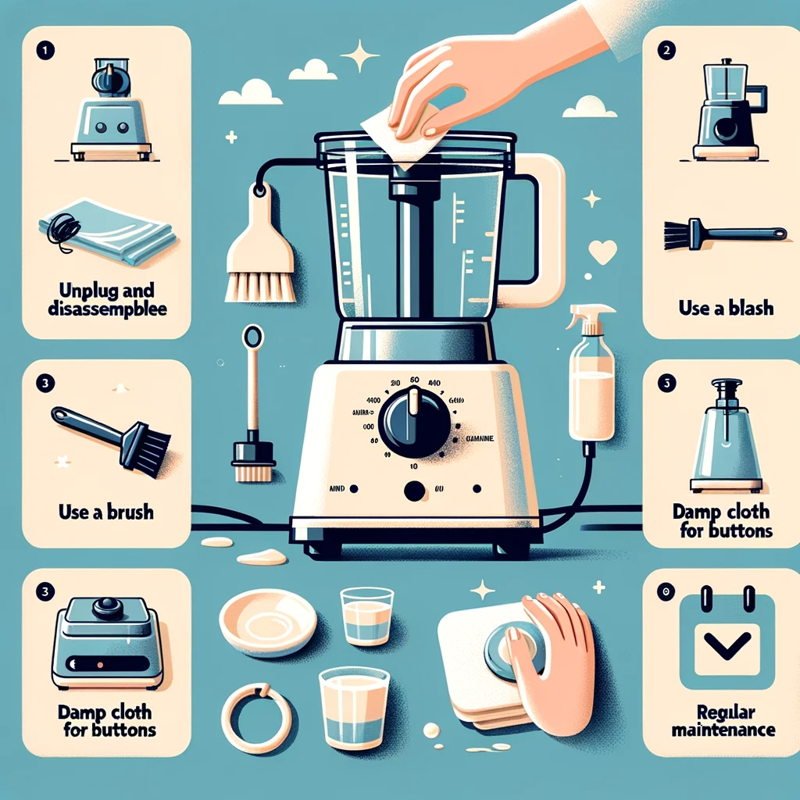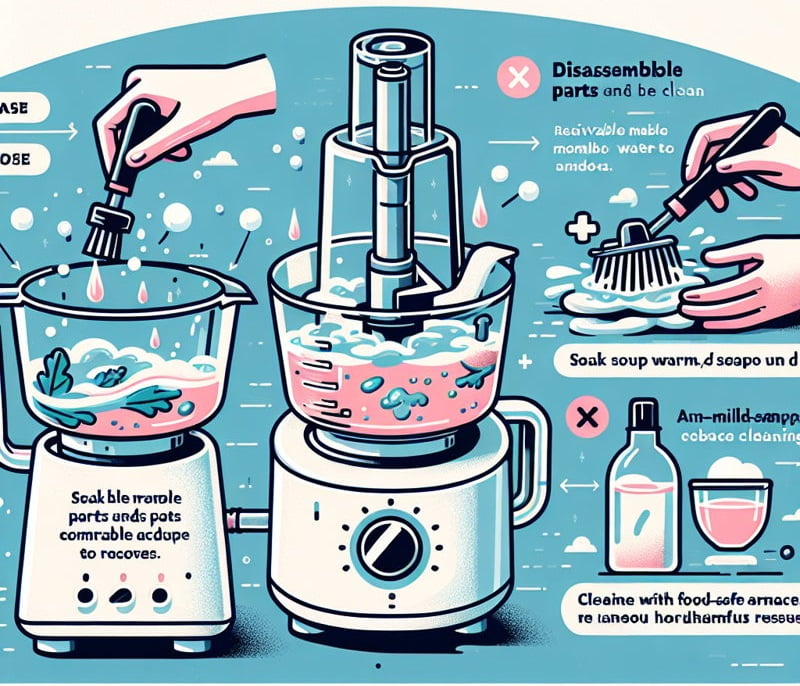Maintaining a clean food processor is essential for both hygiene and functionality. A clean food processor ensures that your meals remain safe and free from contamination. In this guide, we will explore the importance of keeping a food processor clean and provide an overview of the cleaning process. By following these steps, you can extend the lifespan of your appliance and continue to prepare delicious and healthy meals with confidence.
Importance of Keeping a Clean Food Processor
A clean food processor is essential for several reasons. First, a clean food processor ensures the safety of your meals. When contaminants from previous uses are left behind, they can compromise the hygiene of your food, leading to health risks.
Secondly, a properly cleaned food processor preserves the flavor and aroma of your ingredients. Residue from previous recipes can taint the taste of your dishes. Moreover, a meticulously cleaned food processor extends its lifespan, saving you money in the long run.
Regular cleaning also prevents the buildup of stubborn stains and odors. In conclusion, maintaining a clean food processor is crucial for both your health and the quality of your culinary creations.

Preparing for Cleaning
When it comes to maintaining the cleanliness of your food processor, a few essential steps should be followed to ensure the process is both effective and safe.
Unplugging the Appliance
Before you begin cleaning your food processor, the first step is to unplug the appliance. This is a critical safety measure to avoid any accidental starts while you are handling the components.
Disassembling the Parts
Once the food processor is unplugged, the next crucial step is to disassemble the parts. This typically involves removing the blades, containers, and any additional attachments. Disassembling the components makes it easier to access all the nooks and crannies for a thorough cleaning.
By adhering to these initial steps, you are well on your way to properly cleaning your food processor. These precautions ensure safety and ease during the cleaning process, helping you maintain a hygienic kitchen environment.
Cleaning Your Food Processor: A Step-by-Step Guide
Food processors are a versatile kitchen tool that simplifies meal preparation. However, to ensure their longevity and safety, it’s crucial to know how to clean a food processor properly. In this guide, we’ll walk you through the process of cleaning the removable parts, washing blades, bowls, and accessories, tackling stubborn food residues, and safely handling sharp blades.
Cleaning the Removable Parts
- Unplug the Appliance: Before you start cleaning, always ensure that the food processor is unplugged from the power source. Safety first!
- Disassemble: Carefully disassemble the food processor by removing the bowl, lid, blades, and any other detachable parts. Refer to the user manual for guidance.
- Rinse with Warm Water: Begin by rinsing all removable parts under warm running water. This helps remove loose food particles.

Washing Blades, Bowls, and Accessories
- Hand Wash: It’s recommended to hand wash these components with mild dish soap and a soft sponge. Avoid using abrasive scouring pads, as they can damage the surfaces.
- Pay Attention to Blades: Take extra care when cleaning sharp blades. Use a brush or a cloth to clean between the crevices.
Tips for Dealing with Stubborn Food Residues
- Soak in Soapy Water: For stubborn residues, soak the affected parts in warm, soapy water for a few minutes. This will help loosen the stuck-on food.
- Use Baking Soda: A paste of baking soda and water can be effective for scrubbing away tough residues.
Safe Handling of Sharp Blades
- Handle with Caution: When cleaning and storing blades, always handle them with caution. Use protective gloves if necessary.
- Store Safely: To prevent accidents, store blades separately and in a secure place.
By following these cleaning tips, you’ll keep your food processor in excellent condition, ensuring it serves you well for years to come.
Cleaning the Base and Motor
Cleaning your food processor, including the base and motor, is essential to maintaining its hygiene and prolonging its lifespan. Follow these steps to ensure a thorough and safe cleaning process:

- Unplug and disassemble: Before you start, always unplug the food processor from the electrical outlet to ensure safety. Then, carefully disassemble the components, separating the work bowl, blades, and other removable parts from the base.
- Wipe the Base: Begin by wiping the base of the food processor with a damp cloth or sponge. Ensure that the cloth is not overly wet to avoid any electrical damage. Pay special attention to the buttons and crevices where food particles may accumulate.
- Use a Brush: For hard-to-reach areas and stubborn residues, use a small brush with soft bristles. Gently brush away any remaining food debris or dirt from the motor housing.
- Damp Cloth for Buttons: Dampen a cloth with a mixture of mild detergent and water. Wipe the control buttons, taking care not to let any liquid seep into the electrical components.
- Dry Thoroughly: After cleaning, ensure that all parts are completely dry before reassembling and storing your food processor. Moisture in electrical parts can lead to malfunctions or safety hazards.
- Regular Maintenance: To keep your food processor in top condition, clean the base and motor after each use and perform a deep clean periodically. This will not only maintain hygiene but also prevent the buildup of residues that can affect performance.
Drying and Reassembling
When it comes to maintaining your kitchen appliances, cleaning your food processor is crucial. After washing, the next steps are equally important: drying and reassembling. Here’s how to do it right:.

Drying Your Food Processor
After washing each component of your food processor, it’s vital to ensure they are completely dry before reassembly. Here are some tips for proper drying:
- Air Drying: Place the washed parts on a clean towel or drying rack and let them air dry. This helps prevent moisture buildup and ensures no water droplets are left behind.
- Towel Drying: Use a clean, dry kitchen towel or paper towels to gently pat the components dry. Pay special attention to crevices and hard-to-reach areas.
- Compressed Air: For small, intricate parts, consider using compressed air to blow away any remaining moisture. This is especially useful for nooks and crannies.
Reassembling Correctly
Once everything is dry, it’s time to put your food processor back together. Here are some tips for reassembling correctly:
- Refer to the Manual: If you’re unsure about the correct order of assembly, consult your food processor’s manual. It typically provides step-by-step instructions.
- Inspect for residue: Before reassembling, double-check for any lingering food particles or water droplets. Cleaning thoroughly ensures optimal performance.
- Handle with Care: As you reassemble, handle the components gently to avoid forcing any parts together. If something doesn’t fit, review the manual or check for obstructions.
Regular Maintenance and Care for Your Food Processor
Proper maintenance is essential to ensuring your food processor remains in excellent working condition. Here are some tips to help you keep it clean and functional.

Cleaning Frequency
Regular cleaning after each use is crucial for preventing the buildup of food residues. Disassemble the components and wash them with warm, soapy water. Pay special attention to the blades and crevices.
Deep Cleaning
Perform a deep cleaning every few weeks, depending on usage. This involves disassembling the processor entirely and cleaning each part thoroughly. Use a brush or toothpick to remove any stubborn debris.
Storing Your Food Processor
When not in use, store your food processor in a cool, dry place to prevent dust and moisture from accumulating. Keep the parts together to avoid misplacement.
Preventive Measures
To reduce the effort required for cleaning, consider these preventive measures:
- Use cooking spray or oil on the blades to prevent food from sticking.
- Line the work bowl with plastic wrap for easy cleanup.
- Avoid overfilling the bowl to prevent spillage.
- Rinse components immediately after use to prevent the drying of food residues.
Troubleshooting Common Challenges
Food processors are indispensable kitchen appliances, but keeping them clean can sometimes be a challenge. In this guide, we will discuss the best practices for cleaning your food processor and troubleshoot common cleaning challenges.

Removing Odors and Stains
One common issue is lingering odors and stains from previous food processing tasks. To tackle this, start by disassembling the food processor. Soak the removable parts in warm, soapy water for a few hours. For stubborn stains, mix baking soda with water to form a paste and gently scrub the affected areas. Rinse thoroughly to remove any residue.
Dealing with Hard-to-Reach Areas
Food processors have intricate parts that can be tricky to clean. Utilize a small brush or toothbrush to access those hard-to-reach nooks and crannies. Ensure that you clean the base unit with a damp cloth, avoiding contact with electrical components.
Safe Use of Cleaning Agents
When using cleaning agents, opt for mild and food-safe options like white vinegar or lemon juice. Avoid harsh chemicals that can leave harmful residues. Always rinse the components thoroughly with water after using cleaning agents.
Conclusion
Maintaining a clean food processor is crucial for ensuring the safety and hygiene of your kitchen appliances. Regularly cleaning and maintaining kitchen appliances like the food processor not only extends their lifespan but also prevents the buildup of bacteria and food residues.
By following the right steps for cleaning kitchen equipment, you can enjoy hassle-free cooking and peace of mind knowing that your meals are prepared in a clean and healthy environment.
Remember to disassemble the food processor, wash the removable parts, and sanitize it thoroughly to keep it in top-notch condition. A clean food processor is not just a kitchen necessity; it’s a key to healthier and more delicious meals.
 https://bistrovivant.com is a participant in the Amazon Services LLC Associates Program, an affiliate advertising program designed to provide a means for website owners to earn advertising fees by advertising and linking to Amazon (.com,.co.uk,.ca, etc.) and any other website that may be affiliated with the Amazon Service LLC Associates Program. As an Amazon Associate, I earn from qualifying purchases.
https://bistrovivant.com is a participant in the Amazon Services LLC Associates Program, an affiliate advertising program designed to provide a means for website owners to earn advertising fees by advertising and linking to Amazon (.com,.co.uk,.ca, etc.) and any other website that may be affiliated with the Amazon Service LLC Associates Program. As an Amazon Associate, I earn from qualifying purchases.
